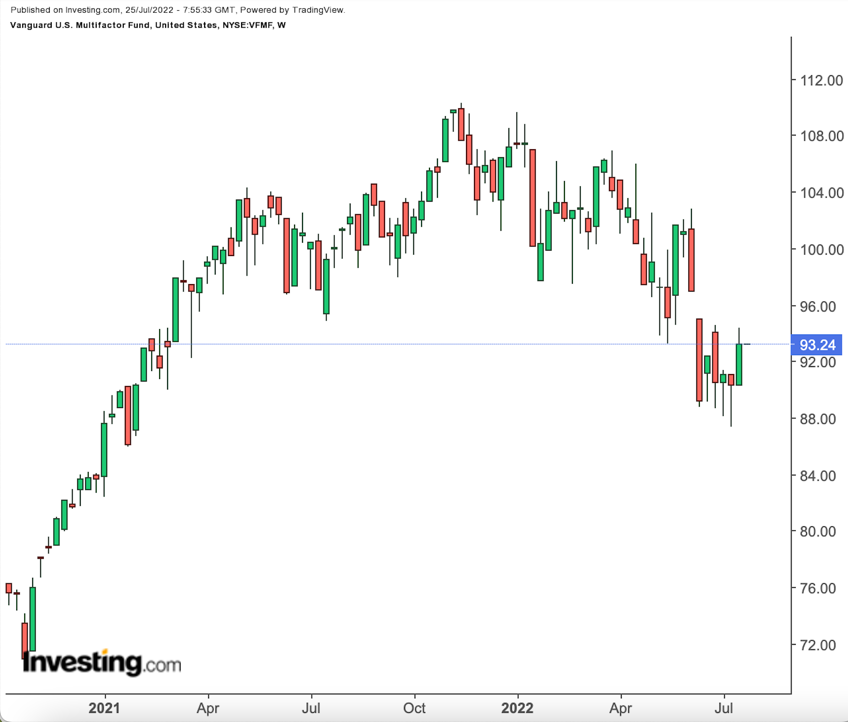- Since January, over 100 new actively managed funds have started trading
- As markets slide, actively managed funds become more appealing
- Note that actively managed funds tend to have higher fees
Investors continue to pour money into actively managed exchange-traded funds (ETFs). The active ETF market in the US grew across all asset classes through the first half, surpassing $300 billion in assets as of June 30. Meanwhile, the industry welcomed 110 new launches in the first half.
Actively managed funds typically have high expense ratios, so it is worth noting that actively managed “funds' performance needs to compensate for their operating costs.” Therefore, investors will need to do further due diligence to see if such funds meet their investment objectives.
With that said, here’re two actively managed funds that may appeal to a range of readers.
1. First Trust Nasdaq BuyWrite Income ETF
- Current Price: $20.69
- 52-week range: $19.46 - $22.98
- Yield: 5.39%
- Expense ratio: 0.85% per year
Investors seeking additional income in a volatile environment are turning to buy-write ETFs that buy a basket of stocks and then sell or write call options on those assets. Regular readers will know that this covered call setup is an options strategy that we regularly cover. Returns typically lag in bull markets but such funds can do better than benchmarks in neutral or bear markets.
The First Trust Nasdaq BuyWrite Income ETF (NASDAQ:FTQI) is an actively managed fund that targets to provide current income. It currently invests in 95 stocks from the NASDAQ Composite index and also writes (sells) calls on the NASDAQ 100 index.

This fund was first listed in January 2014 as the First Trust Hedged BuyWrite Income ETF. At time, it relied on both buying put options and writing call options on the S&P 500 index. However, following an amended investment strategy that consists of selling exchange-traded call options on the NASDAQ 100 Index, it started trading under a new name and ticker as of May 11, 2022.
FTQI is down around 4.3% year-to-date. At present, the yield from the premiums of calls sold stands at 5.39%.
By comparison, the NASDAQ Composite Index has lost over 24% so far in the year. Similarly, the Fidelity® NASDAQ Composite Index® ETF (NASDAQ:ONEQ) has declined about 24%.
Put another way, the covered call strategy has helped investors weather most of the storm in the shares held in the index. A fund like the FTQI can appeal to readers looking for relatively high levels of current income and a hedged exposure to stocks in the NASDAQ Composite.
2. Vanguard US Multifactor ETF
- Current Price: $93.24
- 52-week range: $87.34 - 110.32
- Dividend yield: 1.69%
- Expense ratio: 0.18% per year
The Vanguard US Multifactor Fund (NYSE:VFMF) invests in a wide range of US securities in different market sectors. A quantitative model is employed to create a basket of stocks across several factors, i..e., shares with low volatility, positive price momentum, robust fundamentals, and prices that offer value relative to their fundamentals.
VFMF was launched in February 2018 and tracks the Russell 3000 index as benchmark. The portfolio currently has 559 stocks where the top 10 comprise around 12% of the net assets of $135.2 million. Thus, no single stock is large enough to affect the ETF’s short-term returns.
Financials currently have the largest slice with 19.20%. Next come consumer discretional (15.80%), health care (14.80%), energy (13.40%), industrials (12.10%), consumer staples (8.50%) and others.
Among the leading names are the biopharma heavyweights Pfizer (NYSE:PFE), Bristol-Myers Squibb (NYSE:BMY), AbbVie (NYSE:ABBV) and Regeneron Pharmaceuticals (NASDAQ:REGN) and energy names Exxon Mobil (NYSE:XOM), Chevron (NYSE:CVX) as well as EOG Resources (NYSE:EOG). Alphabet (NASDAQ:GOOGL) is the only tech name among the top 10 stocks.
VFMF is down around 13.0% since January and 6.0% over the past 12 months. By comparison, the S&P 500 index and the Russell 3000 index, the benchmark for the ETF, have lost 16.9% and 17.9% respectively.
The fund’s trailing price-to-earnings (P/E) and price-to-book (P/B) ratios stand at 9.9x and 1.9x. Those metrics for the Russell 3000 are 17.6x and 3.2x. Readers looking for alternative vehicles to navigate choppy markets this earnings season could research VFMF further.
Disclaimer: On the date of publication, Tezcan Gecgil, Ph.D., did not have any positions in the securities mentioned in this article.
